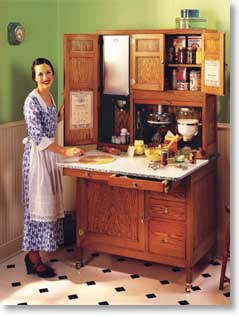
Recipes From
Hoosier Kitchens
And Other Interesting Culinary Facts
and great-grandmothers. Recipes were often shared by neighbors "over
the back fence." Many of the recipes below are identified by the name
of relatives or neighbors from whom they came. I have maintained
authenticity in the transcriptions, and given additional information if needed.

This recipe came from my Grandma Carrie, who lived in Clark County, just across the Ohio river from Louisville, Kentucky. Her mother, who was born in Louisville, undoubtedly made these biscuits. The texture is somewhat of a cross between a dinner roll and a refrigerator biscuit.
| ||||
This cake is cooked, like a custard, on top of the stove until it begins to thicken, then goes into the oven for about 20 minutes at 350-degrees; I bake it in a 10" round pan. After spreading the icing on the cool cake, broil the cake until the icing is bubbly.
|
In 1861 Indianapolis grocer, and once tinsmith, Gilbert C. Van Camp created a process for canning food. However, household use of the can opener did not begin until after 1870. Prior to that cans were opened with a ferocious looking combination of bayonet and sicle, or with a hammer and chisel!
This cobbler is great made with peaches, berries, or rhubarb!
| ||||
 Perhaps the handiest step-saver in the servantless kitchen was the Hoosier
Cabinet. A Hoosier cabinet was the forerunner of our kitchen cabinets and
first manufactured in Indiana (thus, "Hoosier"). Never requiring the housewife
to take a step when a reach would do, the Hoosier Cabinet provided bins
for flour (with a built-in sifter) and sugar; spice racks, shelves, and
lots of little cubbies and shelves for everything from cereals to pot and
pan lids, as well as a porcelain-enameled work surface. There were at least
20 factories turning these out -- "Hoosier," "Napanee" and "Sellers" to
name a few. Click the picture for a larger image
and more information about Hoosier Cabinets and replacement parts.
Perhaps the handiest step-saver in the servantless kitchen was the Hoosier
Cabinet. A Hoosier cabinet was the forerunner of our kitchen cabinets and
first manufactured in Indiana (thus, "Hoosier"). Never requiring the housewife
to take a step when a reach would do, the Hoosier Cabinet provided bins
for flour (with a built-in sifter) and sugar; spice racks, shelves, and
lots of little cubbies and shelves for everything from cereals to pot and
pan lids, as well as a porcelain-enameled work surface. There were at least
20 factories turning these out -- "Hoosier," "Napanee" and "Sellers" to
name a few. Click the picture for a larger image
and more information about Hoosier Cabinets and replacement parts.I think of this next recipe as an 'historical oddity.' I have tested it (baked at 300-degrees) - it is an extremely rich fruit-type cake, with a very strong flavor. It needs to have plenty of whipped cream on top! It must be refrigerated, due to the first ingredient.
| ||||
 Bar Keepers Friend has been manufactured in Indianapolis as a cleanser for brass ornaments since 1882. Quite naturally, they discovered that Bar Keepers Friend
worked equally as well in their homes.
Interestingly, because of pressure from teetotalers during
the early 1900s, the name was changed to "Housekeepers
Friend." Sales dropped so low the owner almost went
bankrupt...and the original name went back on the can.
Bar Keepers Friend has been manufactured in Indianapolis as a cleanser for brass ornaments since 1882. Quite naturally, they discovered that Bar Keepers Friend
worked equally as well in their homes.
Interestingly, because of pressure from teetotalers during
the early 1900s, the name was changed to "Housekeepers
Friend." Sales dropped so low the owner almost went
bankrupt...and the original name went back on the can.See SerVaas Laboratories full line of products.
These were made by my grandmother and her mother before her. Most homemakers knew how to make a crust, so those directions are overlooked). We serve these in a bowl, with a little Mocha Mix (I'm sure my great-grandmother used heavy cream!). Delicious!
| ||||
 Homemakers in Indianapolis would have likely been familiar with the Market House. During the late 19th and early 20th centuries it was the
place where everyone in the city came to buy fresh produce, meat, fish,
poultry, dairy and bakery products. The market at one time hosted more
than 200 vendors. Located at 222 Market St., the Market is still active
today. Click on the photo for more information about the Indianapolis City Market.
Homemakers in Indianapolis would have likely been familiar with the Market House. During the late 19th and early 20th centuries it was the
place where everyone in the city came to buy fresh produce, meat, fish,
poultry, dairy and bakery products. The market at one time hosted more
than 200 vendors. Located at 222 Market St., the Market is still active
today. Click on the photo for more information about the Indianapolis City Market.This dish gives a nod to my German heritage. My family who settled in Indianapolis came from Pennsylvania, and were of German descent. The eggs in this cole slaw add a great flavor.
| ||||
Copyright 2000-2004 Hoosier Home.




